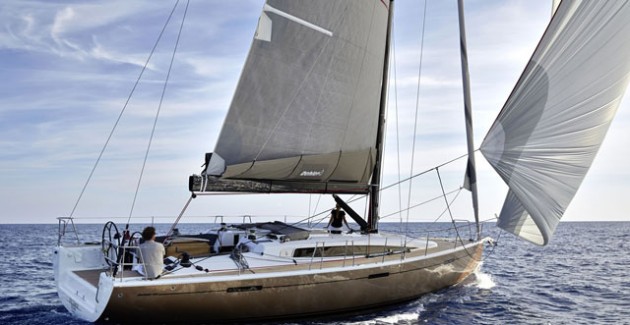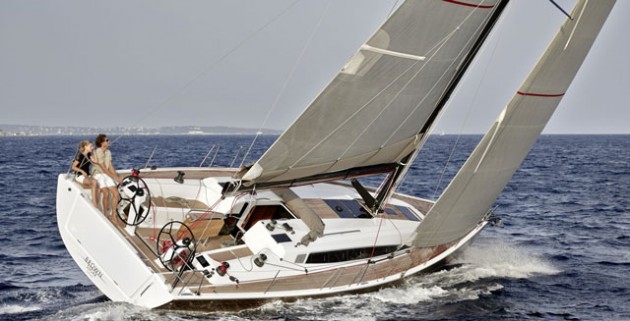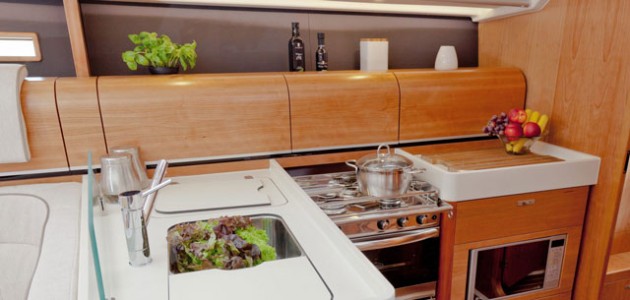Advertisement
Advertisement
Dehler 46: Race, Cruise, Sail
The new flagship for this builder, the Dehler 46 races and cruises equally well.
April 16, 2015
There’s no better way to test a racer/cruiser than to get out with a couple of guys who can’t stop tweaking the sails. On a grey day in San Diego, with a fluky wind, I sailed the new Dehler 46 with two racer/brokers whose restless energy inched this boat up from cruising and more toward the racing side of the equation. Granted, we had nobody to race against, but between Kenyon Martin and Charlie Underwood, we were going to get wherever we were going faster than anyone.
The Dehler 46 looks like it’s in fighting shape even at the dock. The bow and stern are nearly plumb. She has plenty of freeboard but the hard chine, which has become so popular with production boats seeking to maximize interior volume, is definitely missing. The boat looks knife-like from every angle, even from up the mast. The low cabin top has a swoopy eye made of Lexan that covers the fixed hull ports; it seems to be half as high as on other models, which adds to the boat's stealthy appeal.
Dehler shares Hanse’s design group of Judel/Vrolijk, names known for their distinctive and fast hull shapes. The vacuum-infused sandwich construction has an integral carbon-reinforced grid to add stiffness and reduce weight. The fractional rig drives the 24,000 pound boat very efficiently. The tapered, keel-stepped Selden aluminium mast has double aft-swept spreaders and carries a total sail area of 1,228 square feet, split between the overlapping genoa and a traditional mainsail. Three levels of sails are available, including Dacron for cruising, taffeta-covered laminated sails (which were on our test boat), and high performance laminate Elvstrom Epex uber-sails, for when you actually have competition. The standard genoa is 106% and a self-tacking jib is an option, which makes it easy to singlehand.
Rigging and safety
A Pauger carbon-fiber mast and boom are optional in the fully tricked-out model. This competition version, which weights 700 pounds less and adds 70 square feet of sail area, comes with rod rigging and extra winches. Tracks for the genoa are inboard for tight sheeting angles, and the chainplates are outboard with a cover plate that allows access once removed. A composite sprit for an asymmetrical is optional, but almost mandatory, on this spirited boat.
Below the waterline, there are four different keel configurations: shoal at 6’1”, moderate at 7’4” or deep at 8’2” (both T-shaped), and an L-shaped option (since California waters have a way of wrapping kelp on every possible underwater appendage). And because there is little concern about draft around here, the “West Coast” keel is also 8’2”.
A large backing plate at the keel spreads the loads beyond just the keel bolts. Another safety feature is the watertight bulkhead aft of the large sail locker in the bow. Neat molded-in steps lead down into the cavernous locker, and their design maximizes the locker so you can stow fenders or extra line and still have room to inspect the chain just ahead.
Cockpit
The German-style continuous mainsheet is adjustable from either side, with the traveler splitting the cockpit sole just ahead of the twin wheels. That looks more like a racing configuration, but since it really doesn’t get in the way it works even with a bunch of friends aboard for sundowners.
A drop-leaf cockpit table with a pop-up light is bolted on centerline but is removable. The only real handhold in the cockpit is attached to the table, and it would be helpful if the wheels had a binnacle or at least some sort of fixed rail to make it easier to move around when heeling. The transom drops down manually and creates a swim platform. Instruments are at the wheels and include B&G Zeus 2 multifunction displays and H5000 instruments.
Accommodations
“This is a boat that helps you stay married,” said Underwood, when we peeked inside. Sure enough, the Dehler is no bare-bones racing sled. In fact, the furniture is almost too nice to drag wet sails over on race day. (You can get a good look at the interior in our Dehler 46 First Look Video).
The layout includes three cabins and two heads. The port aft cabin is available as either a double, or single plus stowage space. Unfortunately, the only access to that stowage is via an interior door, so there’s no way to drop a rolled-up dinghy down from the cockpit.
The master suite is forward, with a centerline island berth and ensuite head with shower stall. Good stowage and plenty of light and air via the overhead hatch will make the master and her mate quite comfortable. A full guest cabin is aft of the L-shaped galley to starboard. There is a top-loading Isotherm refrigerator and a two-burner Eno stove. It’s not a huge galley, but it’s certainly workable, with decent stowage for provisions and crockery.
A small, forward-facing nav station is to port. This is a feature I love that is disappearing from today’s production boats. Ship’s business is not just about navigation, which many argue can be solved with electronic charts, eliminating the need for a dedicated space. Cruising guides, manuals, notepads, pencils, handheld radios, and all those small sailing gadgets must have their own space, and they will most certainly end up here.
The doors to both heads are quite innovative; they open and close to either entirely enclose the head, or to allow access to the sink while the toilet remains private. It’s brilliant.
The honey-colored oak joinery on our test boat was nicely finished, with smooth surfaces and nice grain detail. The entire saloon looks like the interior of a Boeing airliner, with round-topped cabinets backing the U-shaped settee and movable headrest cushions all around. This being a European boat, there’s an integrated wine rack in the saloon table—of course.
Performance
Our test day was a mix of a sporty breeze and weird lulls, ahead of a building storm. When the puffs came, the Dehler 46 we sailed (which cost just over a half mil as rigged; base boat starts at about 20 percent less) was in her element. On flat water inside San Diego Bay, we came up to 8.6 knots in 17 knots of breeze at 45 degrees apparent wind angle. Because this boat likes to point, we pinched up to 38 degrees before we started to lose speed. As the wind shifted around, we made 7.9 knots in 13 knots of wind on the beam, falling to 6.0 knots at 120 degrees. The helm was light, with one exception: since we left all the canvas up (being too proud and too lazy to reef) there was one moment when the boat headed up, and then up some more. I practically had to stand on it to force her to back down but once she did, the rudder bit and off we went again.
| Specifications | |
|---|---|
| Length | 47'3" |
| Beam | 14'5" |
| Draft (hull) | 6'1"/7'4"/8'2 |
| Sail Area | 1,228 sq. ft. |
| Displacement | 24,316 lbs |
| Fuel capacity | 58 gal. |
| Water capacity | 119 gal. |
The standard engine is a 53 hp Volvo Penta diesel with Saildrive, upgradeable to 75 HP. In flat water with 12 knots of breeze behind us and five people aboard, we motored at 8.4 knots. We came up to 8.7 knots at wide-open throttle and 2950 rpm. With 119 gallons of water and 58 gallons of fuel, the tankage is good for racing and decent for coastal cruising. For anyone wishing to venture farther afield, more tankage would have to be considered.
The Dehler 46 is the kind of boat that will be comfortable for a weekend cruise and make any host proud when entertaining in an anchorage. But many boats will do that. What’s different about this boat is that she will also deliver when it counts—both on the race course, and during the subsequent mandatory dissection of the action afterward, at the bar. She might even deliver when it comes to sailing karate, as her racers’ hands chop-chop to show the angles of how they cut off their opponents at the mark.
See Dehler 46 listings.
Advertisement
Related Boats for Sale
See more boats like thisAdvertisement




















